Saudi Arabia's Government Protectionism: Policies and Impacts
VerifiedAdded on 2022/08/17
|8
|1740
|16
Report
AI Summary
This report analyzes government protectionism in Saudi Arabia, examining its policies and impacts on international trade. The study begins by defining protectionism and its various methods, such as quotas, subsidies, and tariffs, highlighting its objective to protect local businesses from foreign competition. Focusing on Saudi Arabia, the report details specific government procurement decrees, including requirements for Saudi-owned firms and price preferences for GCC goods. It explores the country's economic development strategy post-WTO accession in 2005, its reliance on international trade, and the role of the Ministry of Commerce and Industry in implementing trade policies. The report also covers Saudi Arabia's tariff structure, import bans, and trade imbalances with countries like the U.S. Finally, it discusses the disadvantages of protectionism, including higher consumer prices, potential retaliation from other countries, and the disruption of international trade, emphasizing the potential harm to global economic activities and trade integration.
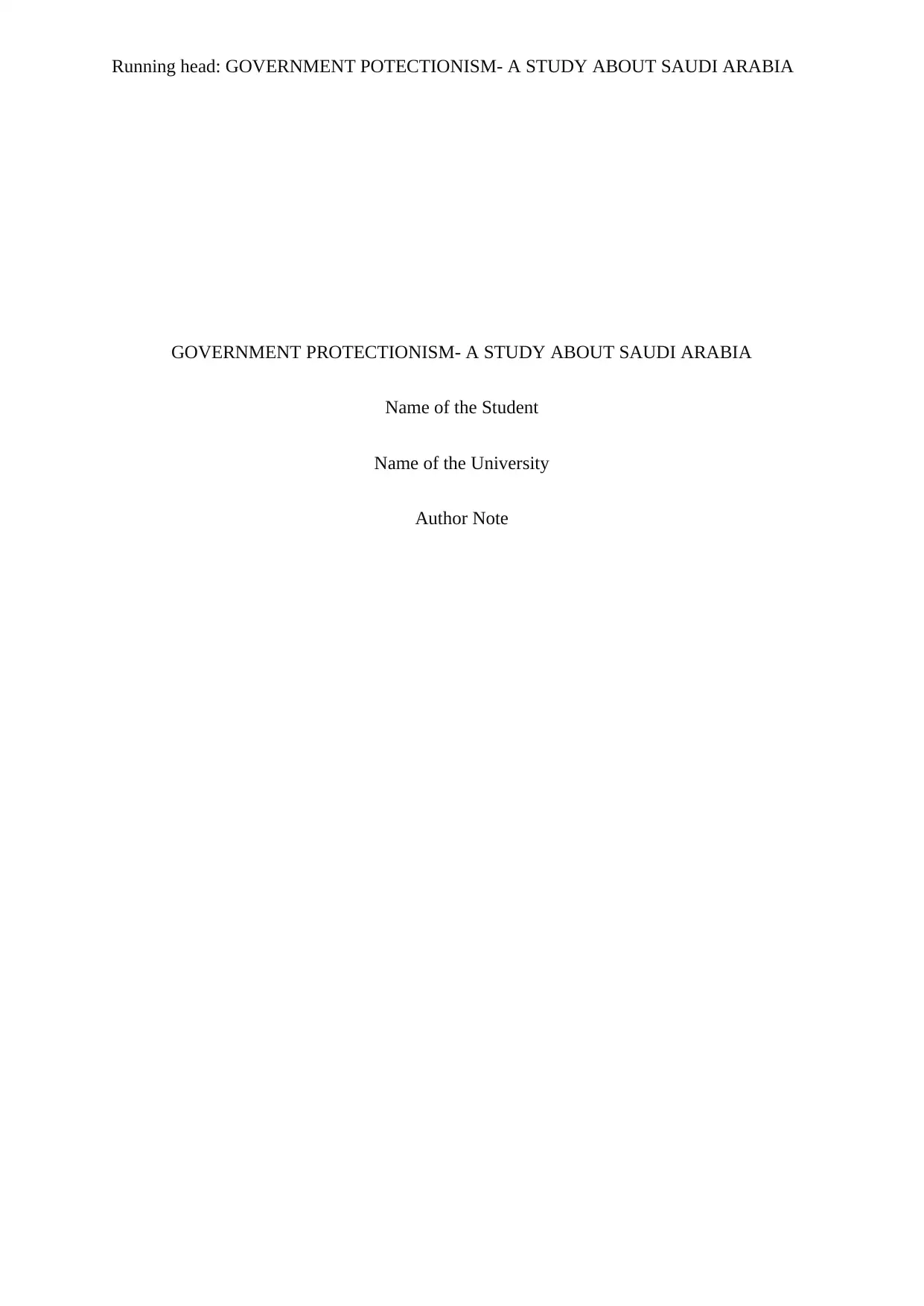
Running head: GOVERNMENT POTECTIONISM- A STUDY ABOUT SAUDI ARABIA
GOVERNMENT PROTECTIONISM- A STUDY ABOUT SAUDI ARABIA
Name of the Student
Name of the University
Author Note
GOVERNMENT PROTECTIONISM- A STUDY ABOUT SAUDI ARABIA
Name of the Student
Name of the University
Author Note
Paraphrase This Document
Need a fresh take? Get an instant paraphrase of this document with our AI Paraphraser
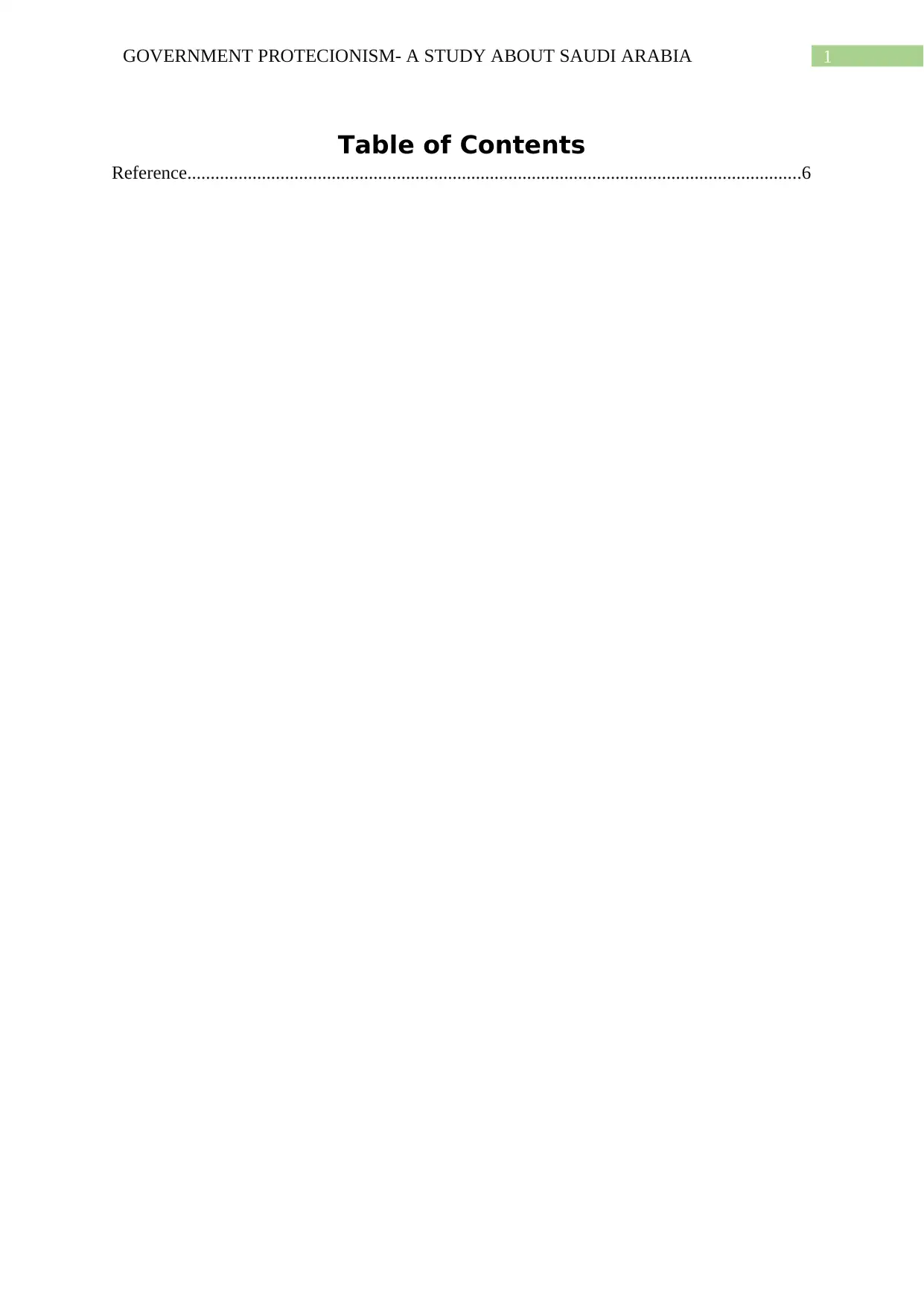
1GOVERNMENT PROTECIONISM- A STUDY ABOUT SAUDI ARABIA
Table of Contents
Reference....................................................................................................................................6
Table of Contents
Reference....................................................................................................................................6
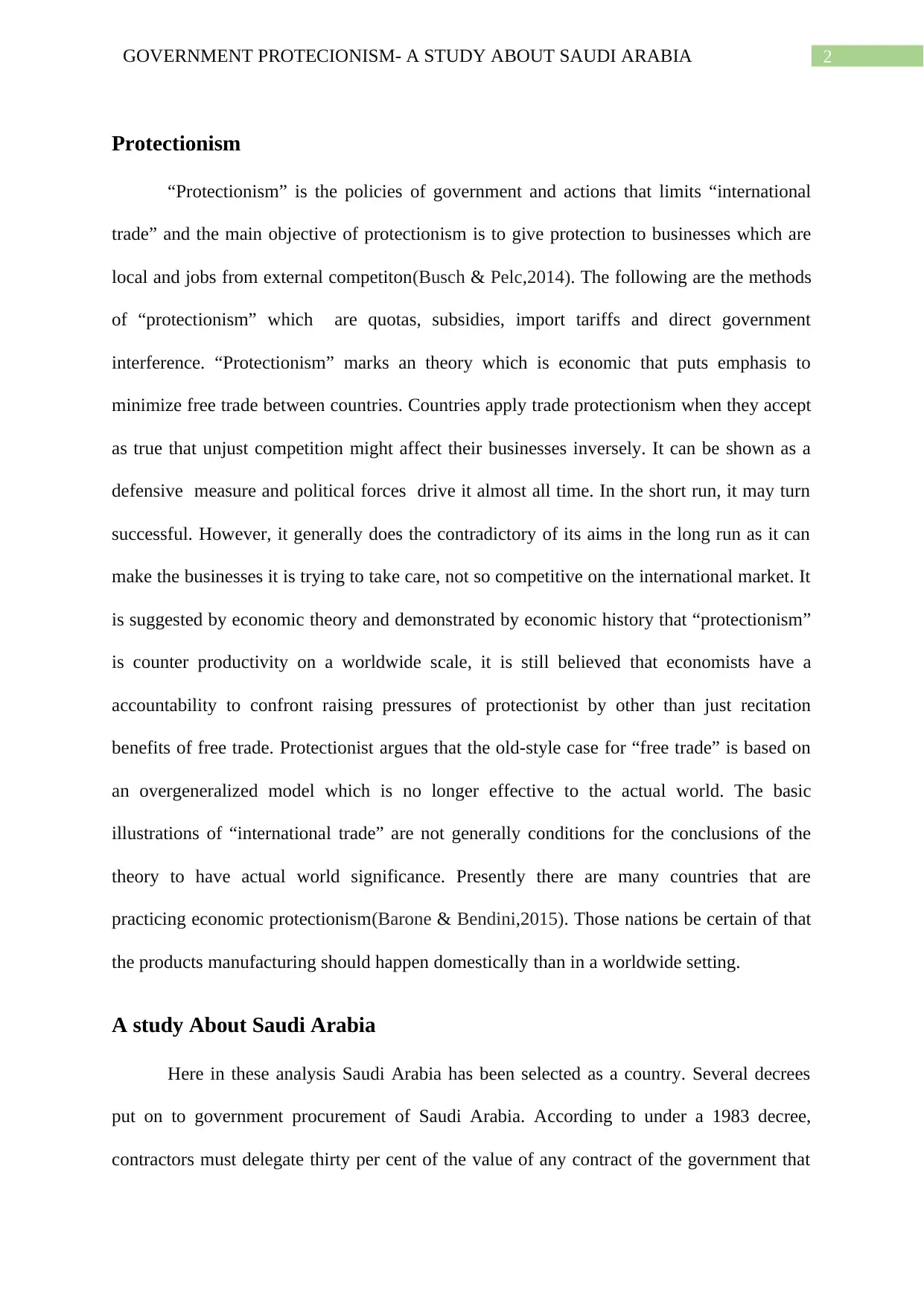
2GOVERNMENT PROTECIONISM- A STUDY ABOUT SAUDI ARABIA
Protectionism
“Protectionism” is the policies of government and actions that limits “international
trade” and the main objective of protectionism is to give protection to businesses which are
local and jobs from external competiton(Busch & Pelc,2014). The following are the methods
of “protectionism” which are quotas, subsidies, import tariffs and direct government
interference. “Protectionism” marks an theory which is economic that puts emphasis to
minimize free trade between countries. Countries apply trade protectionism when they accept
as true that unjust competition might affect their businesses inversely. It can be shown as a
defensive measure and political forces drive it almost all time. In the short run, it may turn
successful. However, it generally does the contradictory of its aims in the long run as it can
make the businesses it is trying to take care, not so competitive on the international market. It
is suggested by economic theory and demonstrated by economic history that “protectionism”
is counter productivity on a worldwide scale, it is still believed that economists have a
accountability to confront raising pressures of protectionist by other than just recitation
benefits of free trade. Protectionist argues that the old-style case for “free trade” is based on
an overgeneralized model which is no longer effective to the actual world. The basic
illustrations of “international trade” are not generally conditions for the conclusions of the
theory to have actual world significance. Presently there are many countries that are
practicing economic protectionism(Barone & Bendini,2015). Those nations be certain of that
the products manufacturing should happen domestically than in a worldwide setting.
A study About Saudi Arabia
Here in these analysis Saudi Arabia has been selected as a country. Several decrees
put on to government procurement of Saudi Arabia. According to under a 1983 decree,
contractors must delegate thirty per cent of the value of any contract of the government that
Protectionism
“Protectionism” is the policies of government and actions that limits “international
trade” and the main objective of protectionism is to give protection to businesses which are
local and jobs from external competiton(Busch & Pelc,2014). The following are the methods
of “protectionism” which are quotas, subsidies, import tariffs and direct government
interference. “Protectionism” marks an theory which is economic that puts emphasis to
minimize free trade between countries. Countries apply trade protectionism when they accept
as true that unjust competition might affect their businesses inversely. It can be shown as a
defensive measure and political forces drive it almost all time. In the short run, it may turn
successful. However, it generally does the contradictory of its aims in the long run as it can
make the businesses it is trying to take care, not so competitive on the international market. It
is suggested by economic theory and demonstrated by economic history that “protectionism”
is counter productivity on a worldwide scale, it is still believed that economists have a
accountability to confront raising pressures of protectionist by other than just recitation
benefits of free trade. Protectionist argues that the old-style case for “free trade” is based on
an overgeneralized model which is no longer effective to the actual world. The basic
illustrations of “international trade” are not generally conditions for the conclusions of the
theory to have actual world significance. Presently there are many countries that are
practicing economic protectionism(Barone & Bendini,2015). Those nations be certain of that
the products manufacturing should happen domestically than in a worldwide setting.
A study About Saudi Arabia
Here in these analysis Saudi Arabia has been selected as a country. Several decrees
put on to government procurement of Saudi Arabia. According to under a 1983 decree,
contractors must delegate thirty per cent of the value of any contract of the government that
⊘ This is a preview!⊘
Do you want full access?
Subscribe today to unlock all pages.

Trusted by 1+ million students worldwide
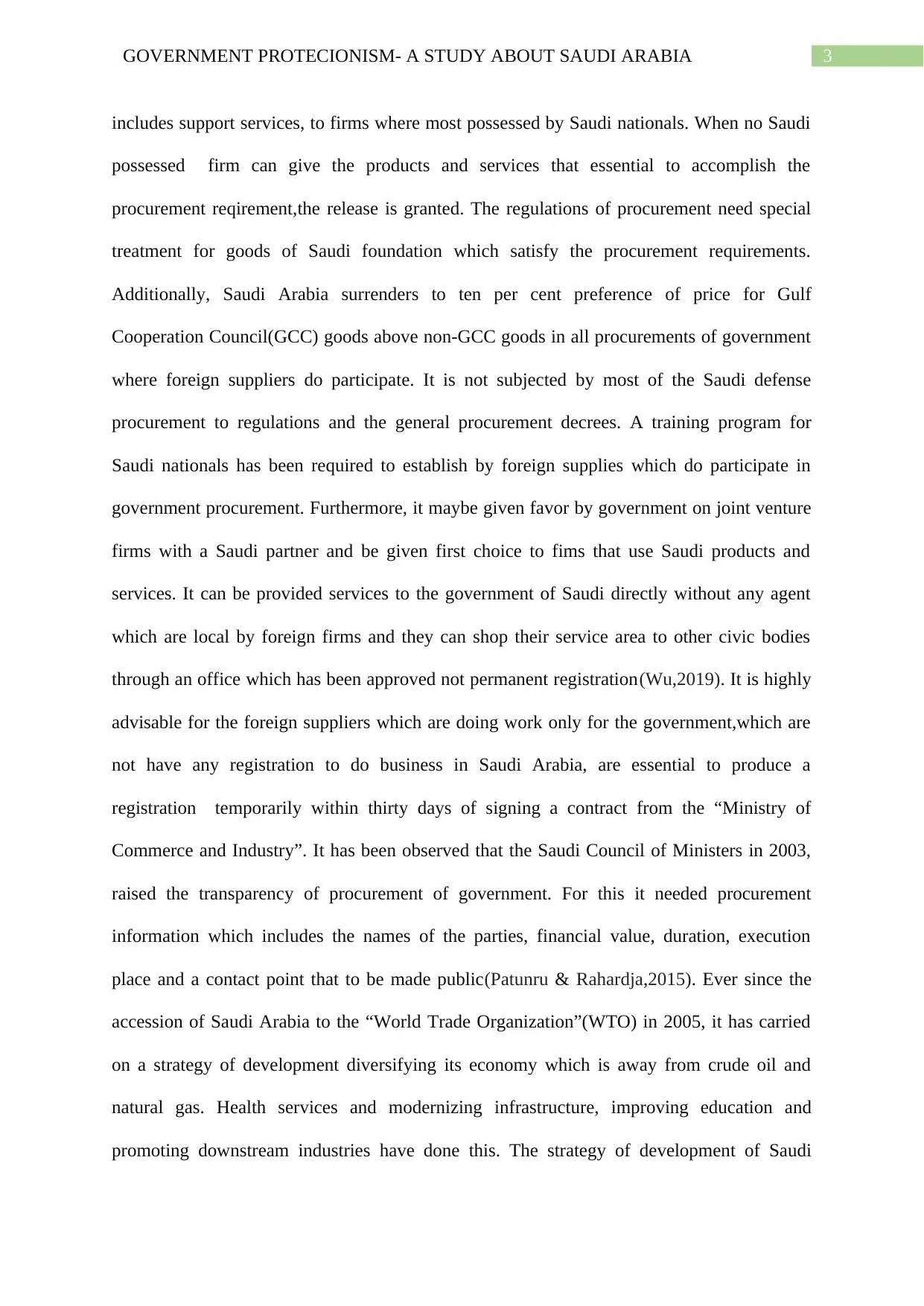
3GOVERNMENT PROTECIONISM- A STUDY ABOUT SAUDI ARABIA
includes support services, to firms where most possessed by Saudi nationals. When no Saudi
possessed firm can give the products and services that essential to accomplish the
procurement reqirement,the release is granted. The regulations of procurement need special
treatment for goods of Saudi foundation which satisfy the procurement requirements.
Additionally, Saudi Arabia surrenders to ten per cent preference of price for Gulf
Cooperation Council(GCC) goods above non-GCC goods in all procurements of government
where foreign suppliers do participate. It is not subjected by most of the Saudi defense
procurement to regulations and the general procurement decrees. A training program for
Saudi nationals has been required to establish by foreign supplies which do participate in
government procurement. Furthermore, it maybe given favor by government on joint venture
firms with a Saudi partner and be given first choice to fims that use Saudi products and
services. It can be provided services to the government of Saudi directly without any agent
which are local by foreign firms and they can shop their service area to other civic bodies
through an office which has been approved not permanent registration(Wu,2019). It is highly
advisable for the foreign suppliers which are doing work only for the government,which are
not have any registration to do business in Saudi Arabia, are essential to produce a
registration temporarily within thirty days of signing a contract from the “Ministry of
Commerce and Industry”. It has been observed that the Saudi Council of Ministers in 2003,
raised the transparency of procurement of government. For this it needed procurement
information which includes the names of the parties, financial value, duration, execution
place and a contact point that to be made public(Patunru & Rahardja,2015). Ever since the
accession of Saudi Arabia to the “World Trade Organization”(WTO) in 2005, it has carried
on a strategy of development diversifying its economy which is away from crude oil and
natural gas. Health services and modernizing infrastructure, improving education and
promoting downstream industries have done this. The strategy of development of Saudi
includes support services, to firms where most possessed by Saudi nationals. When no Saudi
possessed firm can give the products and services that essential to accomplish the
procurement reqirement,the release is granted. The regulations of procurement need special
treatment for goods of Saudi foundation which satisfy the procurement requirements.
Additionally, Saudi Arabia surrenders to ten per cent preference of price for Gulf
Cooperation Council(GCC) goods above non-GCC goods in all procurements of government
where foreign suppliers do participate. It is not subjected by most of the Saudi defense
procurement to regulations and the general procurement decrees. A training program for
Saudi nationals has been required to establish by foreign supplies which do participate in
government procurement. Furthermore, it maybe given favor by government on joint venture
firms with a Saudi partner and be given first choice to fims that use Saudi products and
services. It can be provided services to the government of Saudi directly without any agent
which are local by foreign firms and they can shop their service area to other civic bodies
through an office which has been approved not permanent registration(Wu,2019). It is highly
advisable for the foreign suppliers which are doing work only for the government,which are
not have any registration to do business in Saudi Arabia, are essential to produce a
registration temporarily within thirty days of signing a contract from the “Ministry of
Commerce and Industry”. It has been observed that the Saudi Council of Ministers in 2003,
raised the transparency of procurement of government. For this it needed procurement
information which includes the names of the parties, financial value, duration, execution
place and a contact point that to be made public(Patunru & Rahardja,2015). Ever since the
accession of Saudi Arabia to the “World Trade Organization”(WTO) in 2005, it has carried
on a strategy of development diversifying its economy which is away from crude oil and
natural gas. Health services and modernizing infrastructure, improving education and
promoting downstream industries have done this. The strategy of development of Saudi
Paraphrase This Document
Need a fresh take? Get an instant paraphrase of this document with our AI Paraphraser
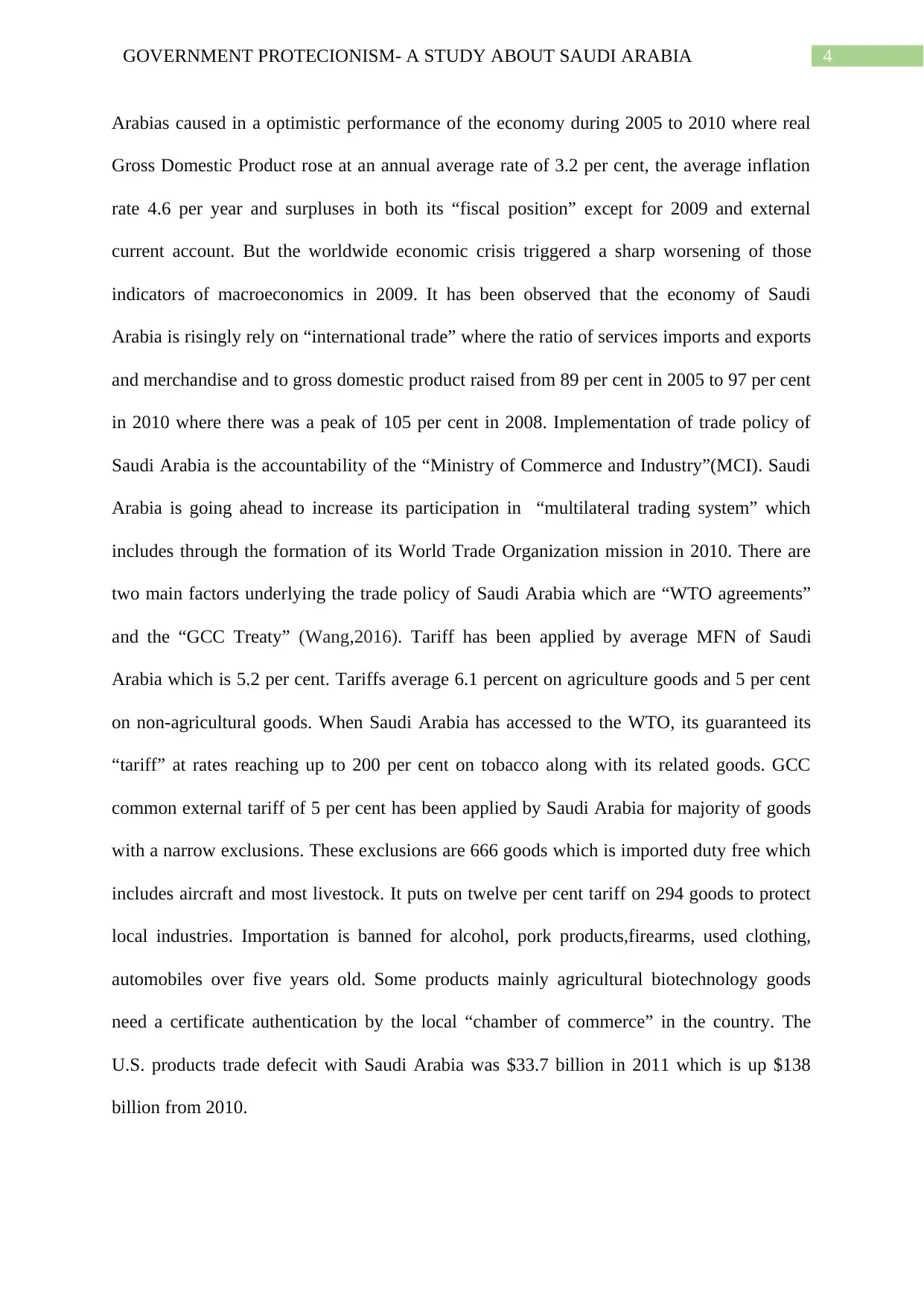
4GOVERNMENT PROTECIONISM- A STUDY ABOUT SAUDI ARABIA
Arabias caused in a optimistic performance of the economy during 2005 to 2010 where real
Gross Domestic Product rose at an annual average rate of 3.2 per cent, the average inflation
rate 4.6 per year and surpluses in both its “fiscal position” except for 2009 and external
current account. But the worldwide economic crisis triggered a sharp worsening of those
indicators of macroeconomics in 2009. It has been observed that the economy of Saudi
Arabia is risingly rely on “international trade” where the ratio of services imports and exports
and merchandise and to gross domestic product raised from 89 per cent in 2005 to 97 per cent
in 2010 where there was a peak of 105 per cent in 2008. Implementation of trade policy of
Saudi Arabia is the accountability of the “Ministry of Commerce and Industry”(MCI). Saudi
Arabia is going ahead to increase its participation in “multilateral trading system” which
includes through the formation of its World Trade Organization mission in 2010. There are
two main factors underlying the trade policy of Saudi Arabia which are “WTO agreements”
and the “GCC Treaty” (Wang,2016). Tariff has been applied by average MFN of Saudi
Arabia which is 5.2 per cent. Tariffs average 6.1 percent on agriculture goods and 5 per cent
on non-agricultural goods. When Saudi Arabia has accessed to the WTO, its guaranteed its
“tariff” at rates reaching up to 200 per cent on tobacco along with its related goods. GCC
common external tariff of 5 per cent has been applied by Saudi Arabia for majority of goods
with a narrow exclusions. These exclusions are 666 goods which is imported duty free which
includes aircraft and most livestock. It puts on twelve per cent tariff on 294 goods to protect
local industries. Importation is banned for alcohol, pork products,firearms, used clothing,
automobiles over five years old. Some products mainly agricultural biotechnology goods
need a certificate authentication by the local “chamber of commerce” in the country. The
U.S. products trade defecit with Saudi Arabia was $33.7 billion in 2011 which is up $138
billion from 2010.
Arabias caused in a optimistic performance of the economy during 2005 to 2010 where real
Gross Domestic Product rose at an annual average rate of 3.2 per cent, the average inflation
rate 4.6 per year and surpluses in both its “fiscal position” except for 2009 and external
current account. But the worldwide economic crisis triggered a sharp worsening of those
indicators of macroeconomics in 2009. It has been observed that the economy of Saudi
Arabia is risingly rely on “international trade” where the ratio of services imports and exports
and merchandise and to gross domestic product raised from 89 per cent in 2005 to 97 per cent
in 2010 where there was a peak of 105 per cent in 2008. Implementation of trade policy of
Saudi Arabia is the accountability of the “Ministry of Commerce and Industry”(MCI). Saudi
Arabia is going ahead to increase its participation in “multilateral trading system” which
includes through the formation of its World Trade Organization mission in 2010. There are
two main factors underlying the trade policy of Saudi Arabia which are “WTO agreements”
and the “GCC Treaty” (Wang,2016). Tariff has been applied by average MFN of Saudi
Arabia which is 5.2 per cent. Tariffs average 6.1 percent on agriculture goods and 5 per cent
on non-agricultural goods. When Saudi Arabia has accessed to the WTO, its guaranteed its
“tariff” at rates reaching up to 200 per cent on tobacco along with its related goods. GCC
common external tariff of 5 per cent has been applied by Saudi Arabia for majority of goods
with a narrow exclusions. These exclusions are 666 goods which is imported duty free which
includes aircraft and most livestock. It puts on twelve per cent tariff on 294 goods to protect
local industries. Importation is banned for alcohol, pork products,firearms, used clothing,
automobiles over five years old. Some products mainly agricultural biotechnology goods
need a certificate authentication by the local “chamber of commerce” in the country. The
U.S. products trade defecit with Saudi Arabia was $33.7 billion in 2011 which is up $138
billion from 2010.
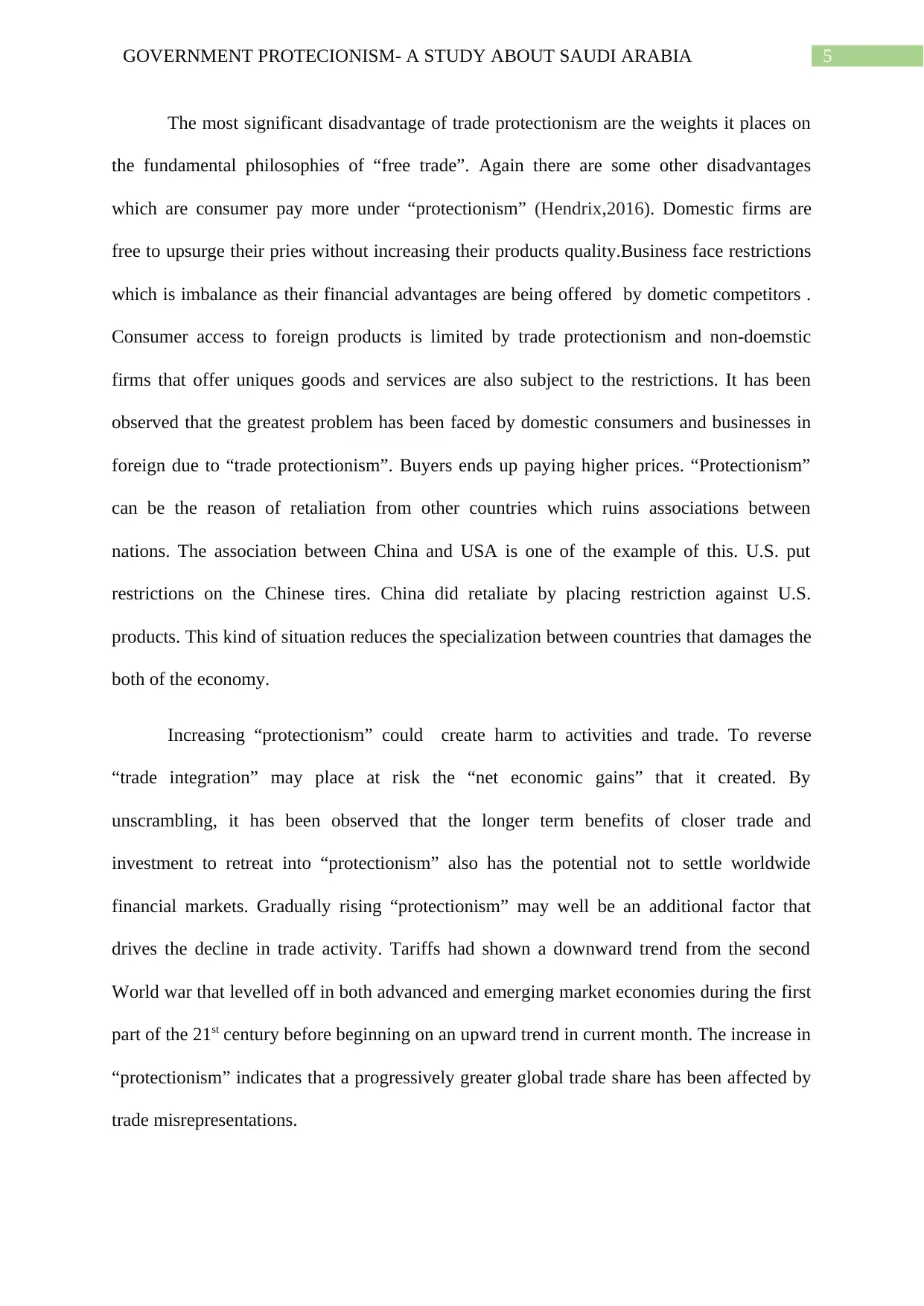
5GOVERNMENT PROTECIONISM- A STUDY ABOUT SAUDI ARABIA
The most significant disadvantage of trade protectionism are the weights it places on
the fundamental philosophies of “free trade”. Again there are some other disadvantages
which are consumer pay more under “protectionism” (Hendrix,2016). Domestic firms are
free to upsurge their pries without increasing their products quality.Business face restrictions
which is imbalance as their financial advantages are being offered by dometic competitors .
Consumer access to foreign products is limited by trade protectionism and non-doemstic
firms that offer uniques goods and services are also subject to the restrictions. It has been
observed that the greatest problem has been faced by domestic consumers and businesses in
foreign due to “trade protectionism”. Buyers ends up paying higher prices. “Protectionism”
can be the reason of retaliation from other countries which ruins associations between
nations. The association between China and USA is one of the example of this. U.S. put
restrictions on the Chinese tires. China did retaliate by placing restriction against U.S.
products. This kind of situation reduces the specialization between countries that damages the
both of the economy.
Increasing “protectionism” could create harm to activities and trade. To reverse
“trade integration” may place at risk the “net economic gains” that it created. By
unscrambling, it has been observed that the longer term benefits of closer trade and
investment to retreat into “protectionism” also has the potential not to settle worldwide
financial markets. Gradually rising “protectionism” may well be an additional factor that
drives the decline in trade activity. Tariffs had shown a downward trend from the second
World war that levelled off in both advanced and emerging market economies during the first
part of the 21st century before beginning on an upward trend in current month. The increase in
“protectionism” indicates that a progressively greater global trade share has been affected by
trade misrepresentations.
The most significant disadvantage of trade protectionism are the weights it places on
the fundamental philosophies of “free trade”. Again there are some other disadvantages
which are consumer pay more under “protectionism” (Hendrix,2016). Domestic firms are
free to upsurge their pries without increasing their products quality.Business face restrictions
which is imbalance as their financial advantages are being offered by dometic competitors .
Consumer access to foreign products is limited by trade protectionism and non-doemstic
firms that offer uniques goods and services are also subject to the restrictions. It has been
observed that the greatest problem has been faced by domestic consumers and businesses in
foreign due to “trade protectionism”. Buyers ends up paying higher prices. “Protectionism”
can be the reason of retaliation from other countries which ruins associations between
nations. The association between China and USA is one of the example of this. U.S. put
restrictions on the Chinese tires. China did retaliate by placing restriction against U.S.
products. This kind of situation reduces the specialization between countries that damages the
both of the economy.
Increasing “protectionism” could create harm to activities and trade. To reverse
“trade integration” may place at risk the “net economic gains” that it created. By
unscrambling, it has been observed that the longer term benefits of closer trade and
investment to retreat into “protectionism” also has the potential not to settle worldwide
financial markets. Gradually rising “protectionism” may well be an additional factor that
drives the decline in trade activity. Tariffs had shown a downward trend from the second
World war that levelled off in both advanced and emerging market economies during the first
part of the 21st century before beginning on an upward trend in current month. The increase in
“protectionism” indicates that a progressively greater global trade share has been affected by
trade misrepresentations.
⊘ This is a preview!⊘
Do you want full access?
Subscribe today to unlock all pages.

Trusted by 1+ million students worldwide
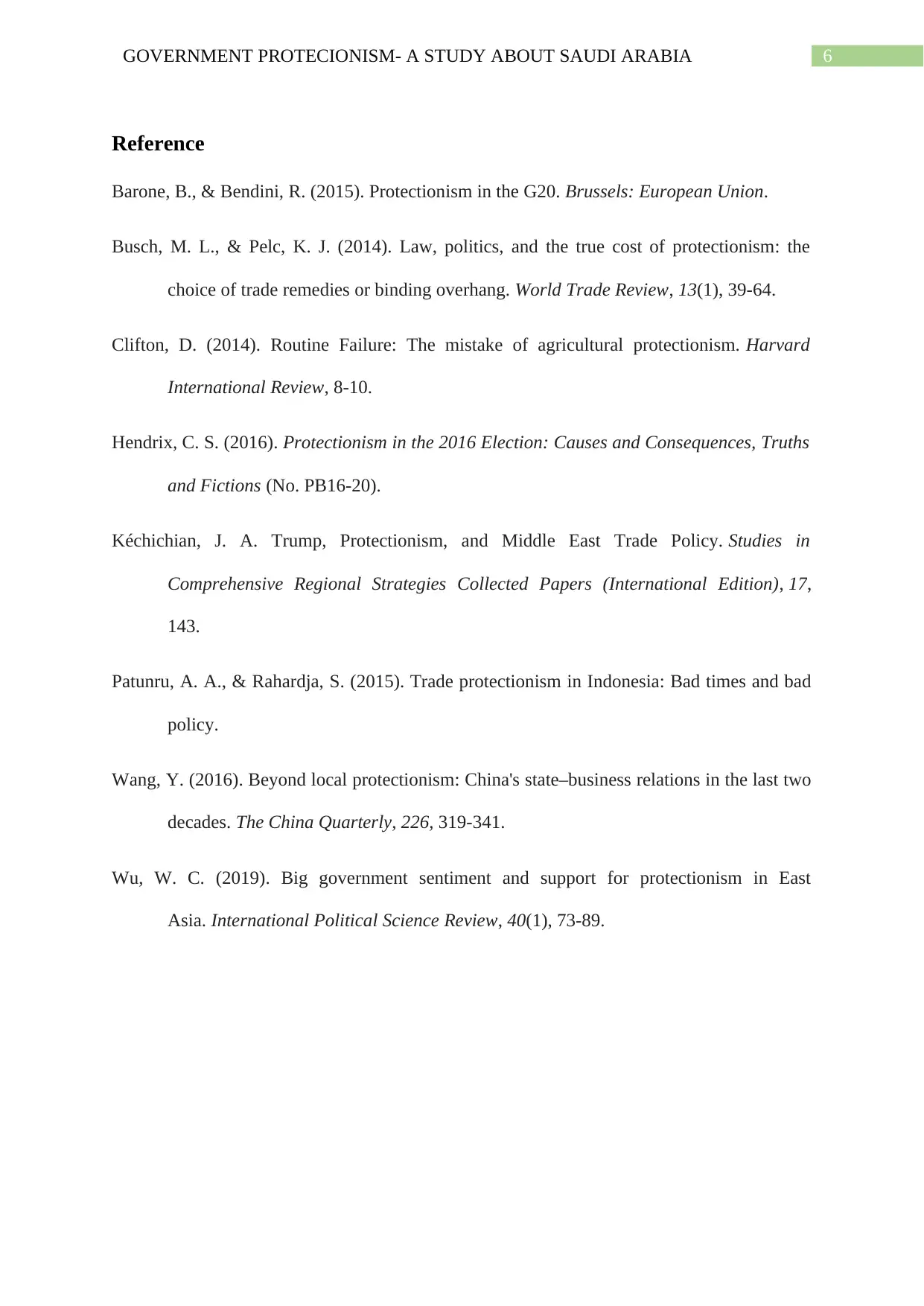
6GOVERNMENT PROTECIONISM- A STUDY ABOUT SAUDI ARABIA
Reference
Barone, B., & Bendini, R. (2015). Protectionism in the G20. Brussels: European Union.
Busch, M. L., & Pelc, K. J. (2014). Law, politics, and the true cost of protectionism: the
choice of trade remedies or binding overhang. World Trade Review, 13(1), 39-64.
Clifton, D. (2014). Routine Failure: The mistake of agricultural protectionism. Harvard
International Review, 8-10.
Hendrix, C. S. (2016). Protectionism in the 2016 Election: Causes and Consequences, Truths
and Fictions (No. PB16-20).
Kéchichian, J. A. Trump, Protectionism, and Middle East Trade Policy. Studies in
Comprehensive Regional Strategies Collected Papers (International Edition), 17,
143.
Patunru, A. A., & Rahardja, S. (2015). Trade protectionism in Indonesia: Bad times and bad
policy.
Wang, Y. (2016). Beyond local protectionism: China's state–business relations in the last two
decades. The China Quarterly, 226, 319-341.
Wu, W. C. (2019). Big government sentiment and support for protectionism in East
Asia. International Political Science Review, 40(1), 73-89.
Reference
Barone, B., & Bendini, R. (2015). Protectionism in the G20. Brussels: European Union.
Busch, M. L., & Pelc, K. J. (2014). Law, politics, and the true cost of protectionism: the
choice of trade remedies or binding overhang. World Trade Review, 13(1), 39-64.
Clifton, D. (2014). Routine Failure: The mistake of agricultural protectionism. Harvard
International Review, 8-10.
Hendrix, C. S. (2016). Protectionism in the 2016 Election: Causes and Consequences, Truths
and Fictions (No. PB16-20).
Kéchichian, J. A. Trump, Protectionism, and Middle East Trade Policy. Studies in
Comprehensive Regional Strategies Collected Papers (International Edition), 17,
143.
Patunru, A. A., & Rahardja, S. (2015). Trade protectionism in Indonesia: Bad times and bad
policy.
Wang, Y. (2016). Beyond local protectionism: China's state–business relations in the last two
decades. The China Quarterly, 226, 319-341.
Wu, W. C. (2019). Big government sentiment and support for protectionism in East
Asia. International Political Science Review, 40(1), 73-89.
Paraphrase This Document
Need a fresh take? Get an instant paraphrase of this document with our AI Paraphraser
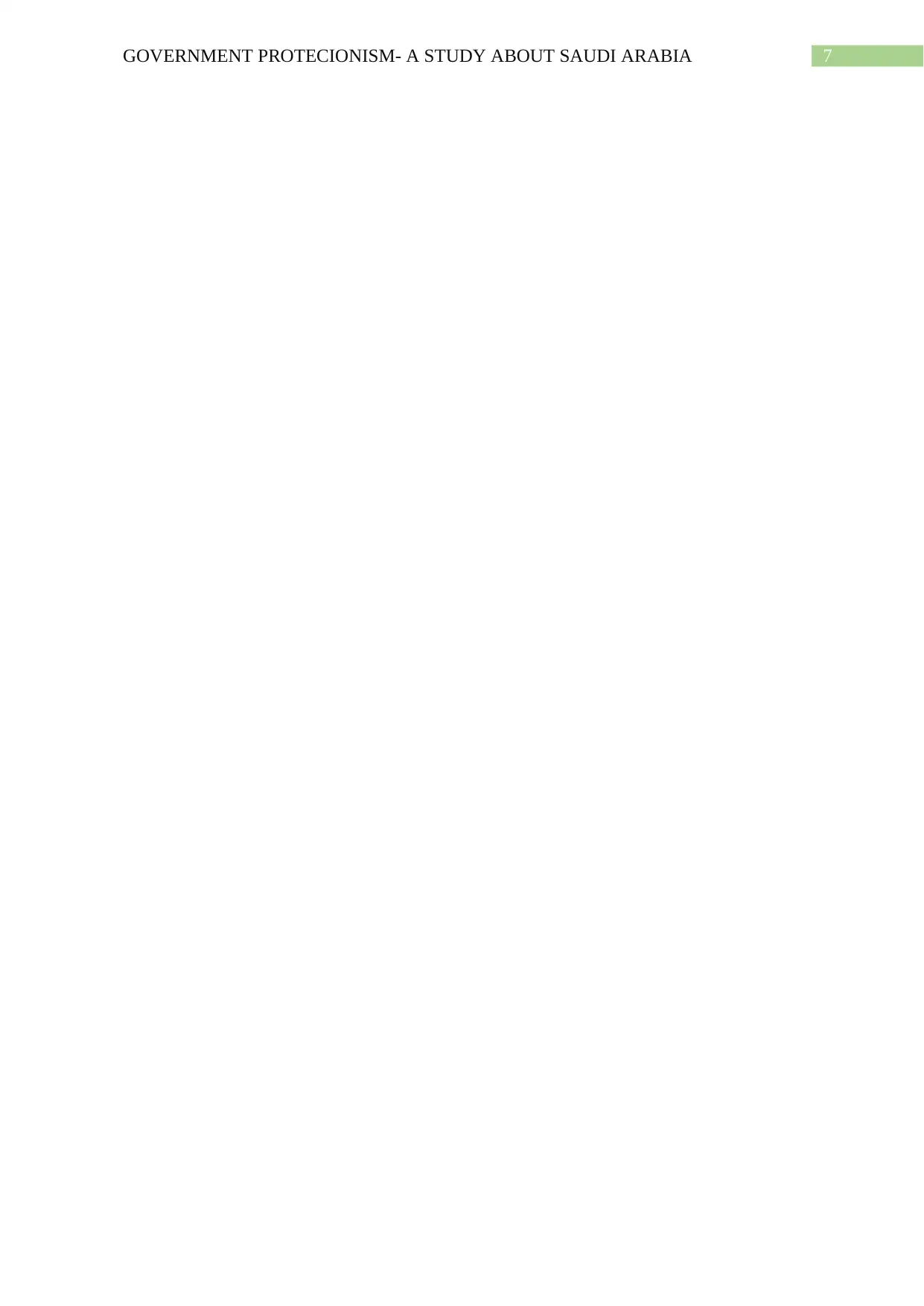
7GOVERNMENT PROTECIONISM- A STUDY ABOUT SAUDI ARABIA
1 out of 8
Related Documents
Your All-in-One AI-Powered Toolkit for Academic Success.
+13062052269
info@desklib.com
Available 24*7 on WhatsApp / Email
![[object Object]](/_next/static/media/star-bottom.7253800d.svg)
Unlock your academic potential
Copyright © 2020–2025 A2Z Services. All Rights Reserved. Developed and managed by ZUCOL.





